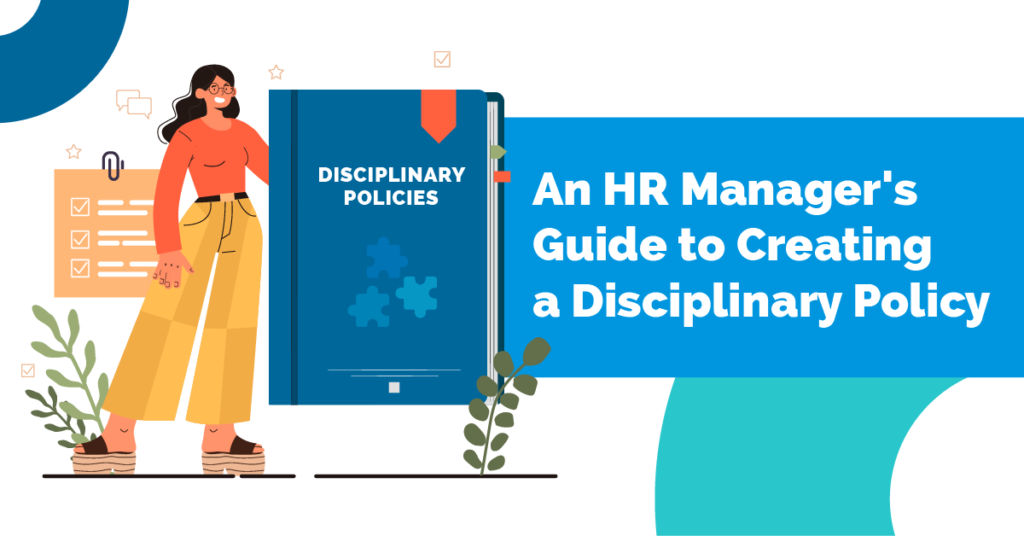
Dealing with employee misconduct is one of the unfortunate realities of managing human resources. It is quite challenging, and proper handling is paramount to prevent an issue from boiling over. Therefore, companies should have a disciplinary policy so concerned parties can go through the procedure fairly and consistently.
The purpose of a disciplinary policy does not end with protecting the welfare of the company and its employees. It should also include standards members must follow to ensure a safe and positive workplace and serve as a way to protect the company from legal ramifications should it come to that.
As business owners or HR managers, you must promote a workspace that’s inclusive and non-toxic. Thus, the creation of this policy falls on your shoulders. Here’s a visual guide on making a comprehensive disciplinary policy.

What Is a Disciplinary Policy?
Conflicts are inevitable in the workplace. Differences in ideas, opinions, and beliefs may result in miscommunication, leading to arguments. However, employers are responsible for keeping a safe and inclusive workplace. This means having the proper measures for conflict resolution and behavioral correction, such as a disciplinary policy.
A disciplinary policy is a standard that provides the step-by-step procedure the company takes to reprimand, warn, or dismiss a wrongful employee. It includes the company rules and code of conduct and the disciplinary actions and consequences the employee may face if they break the rules. It also ensures a fair trial so companies won’t face discriminatory or legal charges.
Why Do You Need a Disciplinary Policy?
Establishes a code of conduct in the workplace
A disciplinary policy provides the guidelines and code of conduct to be followed by your employees. Without it, your team may not feel obligated to uphold your company standards and fail to meet expectations. By outlining the acceptable behavior and what classifies as acts of gross misconduct, you’re giving employees the accountability to adhere to the workplace standards.
Helps in dealing with workplace issues fairly and consistently
When emotions are high, things can get heated, resulting in an altercation between your team members. Disciplinary policies can help resolve conflicts by presenting the investigation process to determine what caused the problem. This can also help you decide the appropriate action to take when an employee’s behavior doesn’t align with the organization’s code of conduct.
Counsels and rehabilitates erring employees
Disciplinary action varies per case. Unless the employee has done a serious offense like physically assaulting someone or stealing from the company, termination isn’t the sole solution for everything. Sometimes, employees may be unaware of their actions or behavior, stopping them from performing as expected. You can take appropriate measures to alert them and help make the workplace better.
Provides a fair mechanism for letting go of errant employees
Not all employees are the right ones for your company. Sometimes, you may encounter a bad hire who doesn’t do their job or promotes a toxic work culture. A disciplinary policy provides employers the right avenue to make fair and objective decisions for cases that require employee termination.
Protects your organization from litigation
As the employer, you are responsible for your employees’ behavior toward your customers, clients, and the general public, especially since they represent the company.
Your code of conduct can indicate the behavior and attitude your employees should have. This way, you can minimize the chances of a staff who displayed bad behavior or committed a serious error going to litigation to contest your decision in the higher courts or labor bureaus.
On top of this, documentation from a disciplinary procedure can help you prove that your decision is fair and appropriate if they claim wrongful dismissal or discrimination.
What Needs to be in the Disciplinary Policy?
Policy Overview
The overview is like an introduction, outlining what your employees may expect to find within the policy. Highlight the policy’s purpose here, so your staff understands its importance. Keep it simple and brief, clearly stating the background and outcomes the policy wants to achieve. You may also include a summary of the procedures your company will take in case of an infraction.
Code of Conduct
This portion of your disciplinary policy includes all the rules and standards your employees must follow. Employer rules often fall into these classifications:
- Day-to-day responsibilities, including attendance, tardiness, dress codes, etc.
- Defining what is allowed according to the culture of the company (e.g., using company laptops for personal use)
- Rules that may result in immediate suspension or termination if not observed
- Concerning serious misconduct
In this part, make sure you clearly state the dos and don’ts in the workplace so your team members understand what behavior is acceptable and what isn’t. For example, state that discrimination, harassment, or retaliation in the workplace will not be tolerated and will result in suspension or immediate discharge.
Forms of Disciplinary Actions
This section concerns itself with the different disciplinary actions your company can take. There are several forms of disciplinary actions, all of which have a corresponding gravity of offense they address. For example, a verbal warning is given to an employee who breaks a minor rule for the first time.
For more serious offenses and misconducts, termination or suspension may follow. Discuss all the possible actions that can be taken and which violations will entail a particular consequence.
Disciplinary Procedures
The procedures section discusses the disciplinary steps based on the gravity of the infraction. Here, you will need to give a detailed explanation per step. For example, those who violate the dress code may receive a verbal warning first, then a written notice if the infraction happens again.
Remember to abide by the steps so that the investigation will be carried out with due process. This will also include documentation, filing of official forms, informing the concerned people, and the measures taken to remedy the situation.
Appeals Procedure
You must include an appeals procedure section to promote fairness and objectivity. Employees reserve the right to appeal disciplinary decisions they disagree with or if they have reason to believe that they have been treated unfairly.
You’ll need to outline these rights clearly for the employees. Since this provides them a formal avenue to air their concerns about the decision, you need to include how they can appeal it through HR. Make sure to state the need to document their grievance to ensure a speedy and fair resolution.
Legal Protection
A thorough disciplinary policy includes a section for legal protection as there may be ramifications if there are none. This can protect your business from litigation if an employee claims discrimination or wrongful termination.
Make sure to consult a legal professional when creating this portion. It should include a statement of your rights to discharge employees at will, informing them of their unacceptable behaviors. This will also state that the company has followed the proper procedures under the circumstances. Doing so prevents superiors from abusing their power and handing out unjust disciplinary actions.
With that, the section requires documentation and collecting evidence to back up the claims of an employee’s behavior issues.
Promoting a Safe and Happy Workplace
A disciplinary policy is needed for any workplace. This provides a way for your company to show what standards your employees need to follow. It also holds your employees accountable for their actions as they strive to meet expectations. With a comprehensive policy, you can promote a safe and productive workplace through effective conflict resolutions and protection from legal ramifications. If your company needs help creating a comprehensive disciplinary policy, Manila Recruitment is a recruitment agency in the Philippines that offers HR and staff management services. Know how we can help your workplace productivity, and contact us today!













